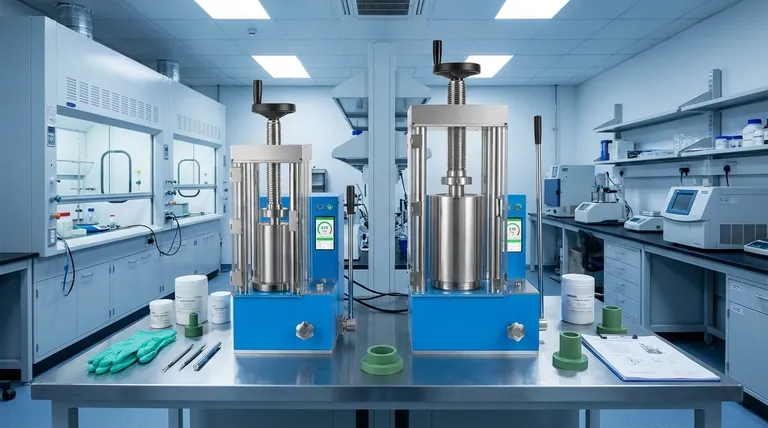For isostatic ceramics, the typical forming pressures are substantial, ranging from 21 to 210 MPa (megapascals), which translates to approximately 3,000 to 30,000 psi. This pressure is applied uniformly via a fluid to compact ceramic powder into a solid, pre-sintered form known as a "green" body.
The specific pressure value is less important than the principle behind it: uniformity. Isostatic pressing uses fluid pressure to compact ceramic powder equally from all directions, creating a highly dense and consistent part that is less prone to defects during final firing.

The Purpose of High, Uniform Pressure
Isostatic pressing is a method of compacting powders into a solid mass before the final heating stage (sintering). The high pressure is the tool, but the goal is to create the best possible starting point for a flawless final component.
The Core Principle: Pascal's Law
The process submerges a flexible mold filled with ceramic powder into a fluid-filled pressure vessel. When the vessel is pressurized, the force is transmitted equally to all surfaces of the mold.
This uniform pressure is the key advantage over methods like uniaxial (single-direction) pressing, which can create density variations within a part.
The Goal: High "Green" Density
The objective of this immense pressure is to create a "green" body with very high density before it ever enters a kiln. This pre-sintered density can reach up to 95% of the ceramic's theoretical maximum density.
Why Green Density Matters
A part with high and uniform green density will shrink less and more predictably during the final sintering stage. This minimizes the risk of internal voids, cracks, and warping, resulting in a stronger, more reliable finished ceramic component.
Understanding the Pressure Range
The wide pressure range of 21 to 210 MPa exists because the ideal pressure is not a single number. It depends heavily on the specific application and material.
Factors Influencing Pressure Selection
The optimal pressure is a function of the ceramic powder's characteristics. Finer powders or those with specific particle shapes may require different pressures to compact effectively compared to coarser powders.
Component Complexity and Desired Properties
The required final properties of the component also dictate the pressure. For high-performance applications demanding maximum strength and reliability, engineers will typically use pressures at the higher end of the scale to eliminate as much initial porosity as possible.
Common Pitfalls and Considerations
While powerful, isostatic pressing involves trade-offs that are critical to understand for any practical application.
Equipment and Tooling Costs
Achieving very high pressures requires robust and expensive pressure vessels and pumping systems. Furthermore, creating the flexible molds used in the process can be more complex and costly than the rigid dies used in other pressing methods.
Green Strength Limitations
Although the green body is highly dense, it has relatively low strength before sintering. Parts must be handled carefully to avoid chipping, cracking, or breaking prior to the final firing stage that gives them their hardness.
Sintering is Still Required
It is crucial to remember that isostatic pressing is an intermediate step. The 95% density is for the unfired part. A final, high-temperature sintering process is always necessary to bond the ceramic particles together and achieve full density and final mechanical properties.
Making the Right Choice for Your Goal
Selecting the appropriate pressure and determining if isostatic pressing is the right method depends entirely on your project's end goal.
- If your primary focus is producing complex shapes with uniform density: Isostatic pressing is an ideal choice, as the fluid pressure conforms perfectly to intricate geometries.
- If your primary focus is maximum strength and reliability in the final part: Using pressures toward the higher end of the range (approaching 210 MPa) is necessary to create the best possible pre-sintered body.
- If your primary focus is high-volume production of simple shapes: Traditional uniaxial dry pressing may be a more cost-effective solution, as it often offers faster cycle times and lower tooling costs.
Ultimately, controlling the pressure in isostatic pressing is about precisely managing the material's initial state to guarantee a predictable and superior final product.
Summary Table:
| Aspect | Key Information |
|---|---|
| Typical Pressure Range | 21 - 210 MPa (approx. 3,000 - 30,000 psi) |
| Primary Goal | Achieve uniform density (up to 95% of theoretical) in the "green" body |
| Key Advantage | Eliminates density variations for complex shapes, minimizing defects |
| Main Consideration | Pressure selection depends on powder characteristics and final part requirements |
Need to produce high-performance ceramic components with uniform density and minimal defects?
At KINTEK, we specialize in providing the precise lab equipment and consumables needed for reliable isostatic pressing and sintering processes. Our expertise helps you achieve the optimal pressure and material state for predictable, superior final products.
Contact our experts today to discuss how we can support your laboratory's ceramic production goals.
Visual Guide

Related Products
- Electric Lab Cold Isostatic Press CIP Machine for Cold Isostatic Pressing
- Manual Cold Isostatic Pressing Machine CIP Pellet Press
- Automatic Lab Cold Isostatic Press CIP Machine Cold Isostatic Pressing
- Laboratory Hydraulic Press Split Electric Lab Pellet Press
- Warm Isostatic Press for Solid State Battery Research
People Also Ask
- What is a cold isostatic press? Achieve Uniform Powder Compaction for Complex Parts
- What is the process of isostatic graphite? A Guide to High-Performance, Uniform Material Creation
- How big is the isostatic pressing market? A Deep Dive into the $1.2B+ Advanced Manufacturing Enabler
- What is the difference between sintering and pressing? A Guide to Powder Metallurgy Processes
- Why is cold working better than hot working? A Guide to Choosing the Right Metal Forming Process



















